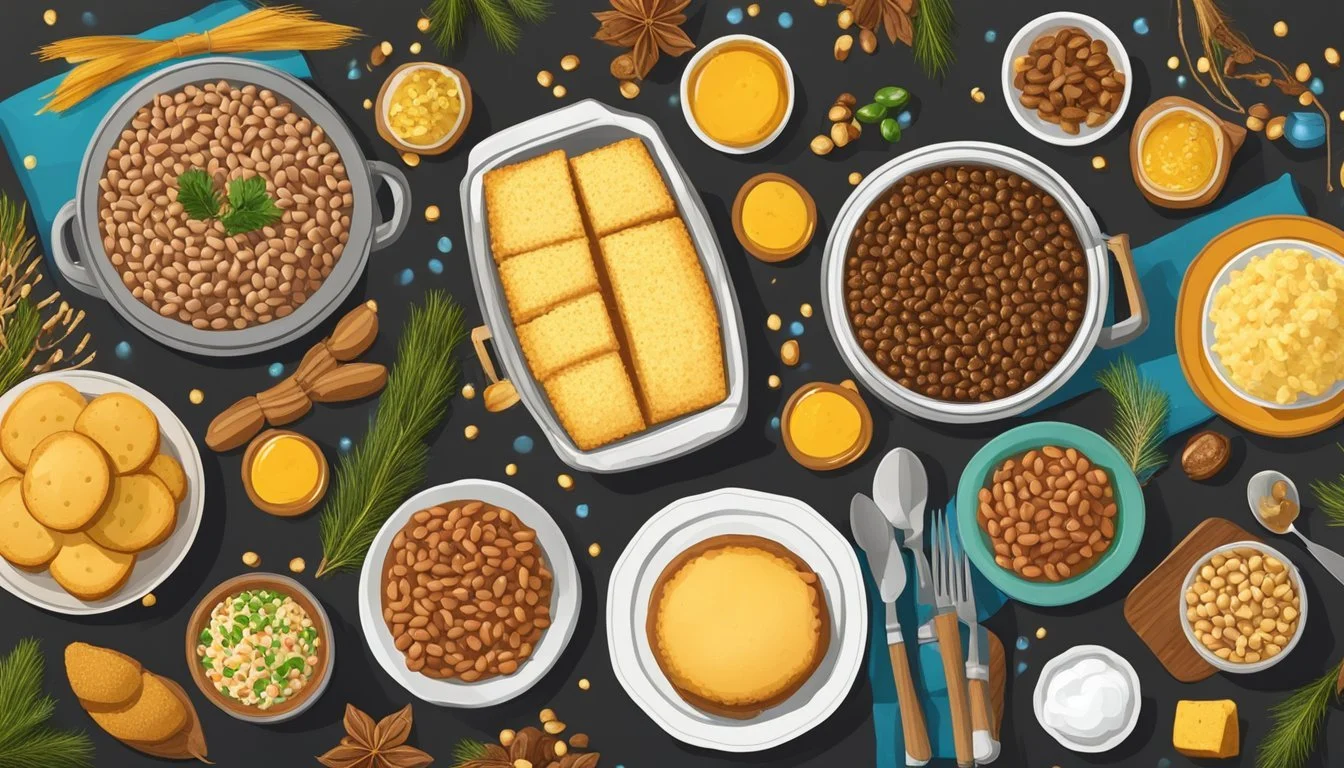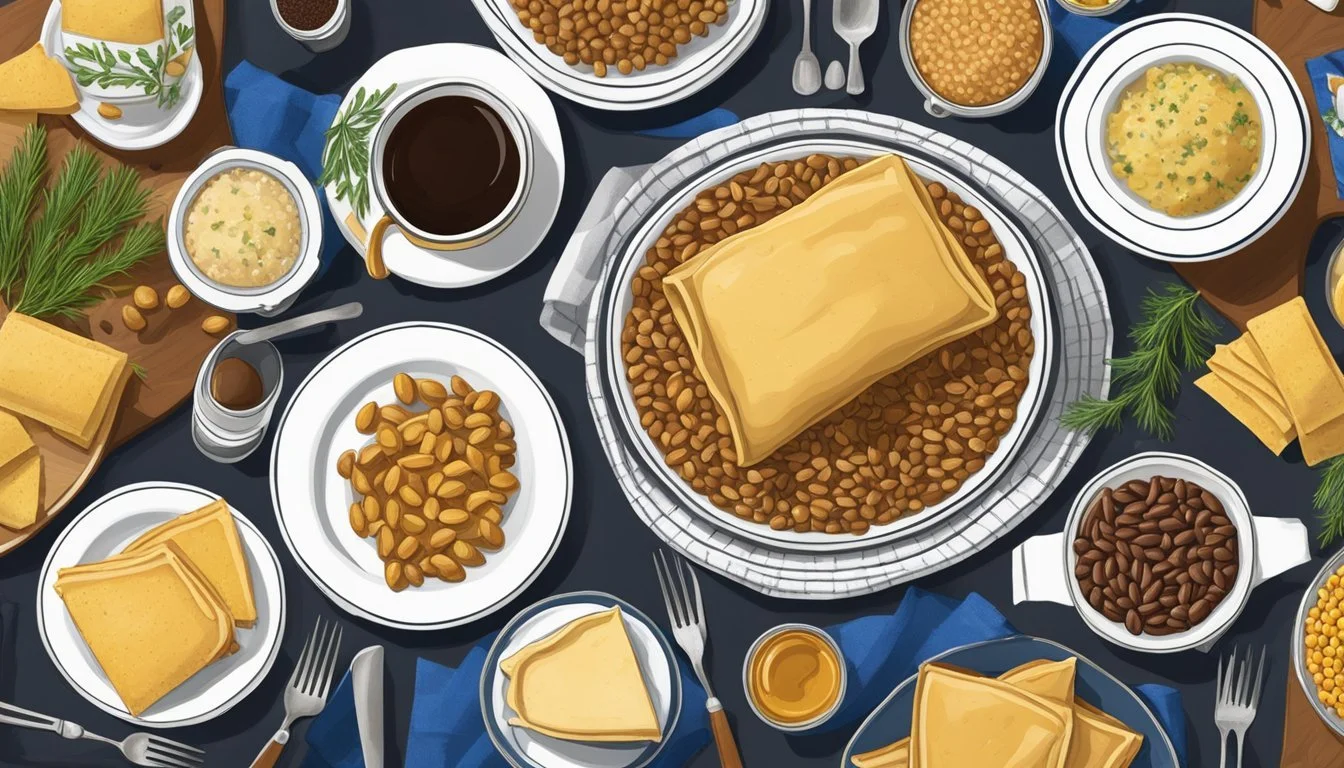7 Texas Food Traditions for New Year’s Eve
Celebrate with Authentic Flavor
Food plays a significant role in New Year's Eve celebrations across various cultures, and Texas is no exception. With its rich culinary heritage and diverse influences, Texas boasts a number of unique food traditions that add flavor to the festivities. From savory dishes to sweet treats, each tradition carries its own significance and offers a delicious way to ring in the new year.
Understanding these traditions provides valuable insight into the ways Texans celebrate and the meanings behind their chosen New Year's Eve foods. These customs not only reflect the state's history and cultural amalgamation but also offer a fun and tasty way to mark the transition into a new year.
1) Black-Eyed Peas
Eating black-eyed peas on New Year's Eve is a cherished Texas tradition. Rooted in Southern culture, this custom dates back to the 1860s. Black-eyed peas are believed to bring good luck and prosperity for the coming year.
The peas symbolize coins, complementing other symbolic foods like collard greens and cornbread. Collard greens represent paper money, while cornbread signifies gold.
Preparation often involves simmering the peas in chicken stock or water, along with seasonings like thyme, salt, and pepper. Many recipes include bacon or ham for added flavor.
In Texas, a popular variant includes adding jalapeños, tomatoes, and chili powder for a spicy kick. Whichever recipe you choose, enjoying black-eyed peas on New Year's Eve connects you to a long-standing tradition of hope and prosperity.
2) Cornbread
Cornbread holds a special place in Texas New Year’s Eve celebrations. Its golden hue is often symbolized as gold, representing prosperity and good fortune for the coming year.
Texans typically make cornbread with basic ingredients like cornmeal, eggs, milk or buttermilk, and sometimes add cheese for a richer flavor profile. Buttermilk adds a tangy taste that many Texans cherish.
Baking cornbread in a cast-iron skillet is a beloved method. This gives the bread a crispy crust and tender interior. The round shape of skillet cornbread, often perceived as a symbol of wealth, is another reason for its New Year popularity.
Some families incorporate jalapeños or green chilies to add a spicy kick. This variation aligns well with Texas’s love for bold flavors. Adding whole corn kernels into the batter is also a common practice to enhance texture.
Cornbread often accompanies other traditional dishes like black-eyed peas and collard greens during New Year’s feasts. These pairings not only harmonize in flavor but are also steeped in cultural significance.
In summary, cornbread’s prominence in Texas New Year’s Eve meals is a cherished tradition, embodying warmth, prosperity, and delicious simplicity.
3) Tamales
Tamales hold a special place in Texan holiday traditions, particularly during New Year's Eve. Originating from Mesoamerican cuisine, these bundles of joy have become a cherished part of Texan culture. The making of tamales often involves a communal activity known as a tamalada, where families and friends gather to prepare them.
The preparation process involves masa dough, typically made from corn, combined with various fillings such as meats, cheeses, and chilies. The masa and fillings are wrapped in corn husks and then steamed. This method gives tamales their distinct texture and flavor that Texans love.
Apart from their delectable taste, tamales symbolize unity and togetherness. Preparing tamales is more than just cooking; it's a tradition that reinforces family bonds. As families gather to make and share tamales, stories and laughter abound, making it a memorable experience.
In cities like El Paso, tamales are especially favored during the holiday season. Local businesses and home cooks alike pride themselves on producing some of the best tamales. These tamales are often shared with neighbors and extended family, further spreading the festive spirit.
Tamales are also associated with luck and prosperity for the New Year. It is believed that sharing tamales can bring good fortune to those who partake. As a result, they hold an esteemed place in New Year’s Eve celebrations across Texas.
From small family kitchens to popular eateries, tamales remain a cornerstone of Texan culinary traditions, embodying both flavor and festivity.
4) Texas Caviar
Texas Caviar, also known as cowboy caviar, is a vibrant and flavorful dish that originated in Texas around the 1940s. Helen Corbitt, a renowned chef, first created and served it at the Houston Country Club for a New Year's Eve celebration.
The dish consists primarily of black-eyed peas, which are marinated and mixed with a variety of fresh vegetables such as tomatoes, onions, and peppers.
One of the key aspects of Texas Caviar is its versatility. It can be enjoyed as a salad, appetizer, or side dish. The combination of vinegar and oil in the marinade helps to enhance the flavors of the vegetables and peas, making it a refreshing addition to any New Year’s Eve table.
It’s commonly served with tortilla chips, adding a crunchy texture that complements the softness of the peas. This makes it a popular choice for gatherings and festive occasions.
By incorporating fresh herbs and spices, Texas Caviar brings a burst of flavor that embodies the essence of Texan cuisine. It's not only delicious but also healthy, as it is packed with nutrients from the vegetables and legumes.
For those looking to try something new, Texas Caviar is a perfect dish to start the New Year with a taste of the Lone Star State.
5) King Ranch Casserole
King Ranch Casserole is a staple comfort food in many Texas homes, especially during festive gatherings like New Year's Eve. Named after the historic King Ranch in Texas, this dish combines the rich flavors of Tex-Mex cuisine with a hearty, satisfying nature.
At its core, King Ranch Casserole features layers of seasoned chicken, corn tortillas, and a creamy mixture of soups and spices.
The preparation usually involves cooking chicken, which can be done using various methods such as sous-vide or traditional boiling.
Once the chicken is ready, it’s shredded and layered in a baking dish. Common ingredients include sautéed onions, bell peppers, and jalapeños to add a depth of flavor.
The sauce is a combination of milk, chicken stock, and spices like cumin and chili powder.
Each layer of tortillas is topped with the chicken-sauce mixture and cheese, making it both creamy and cheesy.
Baking at 375℉ for about 30-40 minutes finishes off this magnificent casserole.
It’s often served at family gatherings, potlucks, and other festive events for its homely appeal and delicious taste.
6) Pecan Pie
Pecan pie stands as a symbol of Texas culinary heritage, particularly around celebrations like New Year’s Eve. The pie features a rich filling made from a mix of sugar, syrup, eggs, and butter. Often, a splash of bourbon is added for depth.
The crust provides the essential base, and it’s important not to overcook it. A perfect pecan pie requires attention to both the filling and the crust. The filling should be smooth and homogenous before it’s poured over the pecans.
Emporium Pies, a specialty pie shop, is renowned for its Texas pecan pies. Founded in Oak Cliff, it now has locations across Fort Worth, Deep Ellum, and McKinney. The shop prides itself on using freshly picked Texas pecans.
For a homemade version, preheat your oven to 350 degrees Fahrenheit. Combine corn syrup, eggs, vanilla, sugar, and salt in a bowl. Once the mixture is ready, pour it over the pecans, ensuring even distribution.
Bake for approximately 45-50 minutes until it sets perfectly. Specialty shops and home bakers alike agree: the key is the quality of the ingredients and the precision in the baking process.
Emporium Pies is located at 314 N Bishop Ave, Dallas, TX 75208 and can be reached at (469) 206-6126. More information and orders can be placed on their website at emporiumpies.com.
7) Kolaches
Kolaches, a pastry with deep roots in Texas, are a staple during New Year’s Eve celebrations in the state. Originally brought by Czech immigrants in the late 1800s, these round yeasted dough pastries have become a beloved part of Texas food culture.
Traditionally, kolaches are filled with fruits, nuts, or sweet cheeses. Cream cheese kolaches are particularly popular, often topped with a streusel for added crunch. Texas variants sometimes feature savory fillings such as sausage, known locally as "klobasneks."
Many Texas bakeries excel in kolache-making, with roadside bakeries and local shops offering their own unique takes. Bexar Kolaches, for instance, started in December 2020, has quickly gained acclaim.
For a taste of authentic Texas kolaches, visit My Texas Kitchen or The Kitchn, both known for their delicious recipes and quality ingredients. The strong presence of kolache shops across Texas highways ensures that anyone can indulge in this delightful pastry during New Year's celebrations.
Kolaches are usually enjoyed as breakfast on New Year's Eve or served as snacks throughout the night. Their versatility makes them a perfect choice for gatherings, ensuring that there's a flavor for everyone.
Historical Significance of Texas Food Traditions
Texas food traditions are deeply rooted in the state’s diverse cultural history, influenced by multiple groups and evolving through generations. These traditions reflect the dynamic interplay of various cultures and the adaptations made over time.
Origins of Traditional Dishes
Texas cuisine has been shaped by indigenous peoples, Mexican influences, and European settlers. Native Americans introduced corn and beans, which became staples in many Texan dishes. The influence of Tejano/Mexican culture is evident in the popularity of Tex-Mex foods, blending Mexican and Texas recipes. Dishes such as tamales and chili con carne showcase this fusion.
European settlers, including Germans and Czechs, brought sausages and pastries. This mix of cultural inputs formed the foundation of various traditional Texas dishes. African-American contributions, especially in barbecue, added another layer to Texas cuisine. Each group’s culinary practices integrated, leading to a unique Texan flavor profile.
Evolution Over the Years
Over the years, Texas food traditions have evolved while maintaining their core elements. Innovations in cooking techniques and ingredient availability have expanded the culinary landscape. For instance, barbecue methods have refined, with different regions developing unique styles—Central Texas known for beef brisket and East Texas for slow-cooked pork.
Celebrations like Juneteenth have also influenced food traditions, introducing widespread barbecues and festive meals commemorating historical events. The adaptation of these dishes over time underscores the dynamic and evolving nature of Texas cuisine. While honoring original recipes, Texas food culture continues to adapt, incorporating modern twists and new culinary trends.
Cultural Importance of Food Traditions
New Year's Eve food traditions in Texas play a crucial role in fostering togetherness and are laden with symbolism tied to luck and prosperity.
Family and Community Gatherings
In Texas, New Year’s Eve is a time for families to gather and share a meal filled with meaning. For many, dishes like black-eyed peas and coleslaw serve more than just nourishment. These meals provide an opportunity for relatives and friends to come together and bond over shared customs.
Community celebrations often extend to larger gatherings, bringing neighborhoods closer. These meals foster a sense of community and belonging. Traditional foods become a touchstone for cultural heritage, helping families pass these customs down to future generations.
Symbolism and Superstitions
Every food item on the New Year’s Eve table carries specific symbols and superstitions intended to bring good fortune. Black-eyed peas are regarded as a symbol of prosperity and luck. Consuming them at the start of the year is believed to offer protection against misfortune.
Cabbage, often turned into coleslaw, symbolizes wealth due to its green color, reminiscent of money. Dumplings have a unique place in Chinese Texan communities, symbolizing unity and good luck. Finding special items inside dumplings can predict wealth or longevity.
These superstitions are deeply integrated into the culture, offering a blend of history and hopeful aspirations for the future. They provide both a sense of continuity and a celebration of cultural identity.







